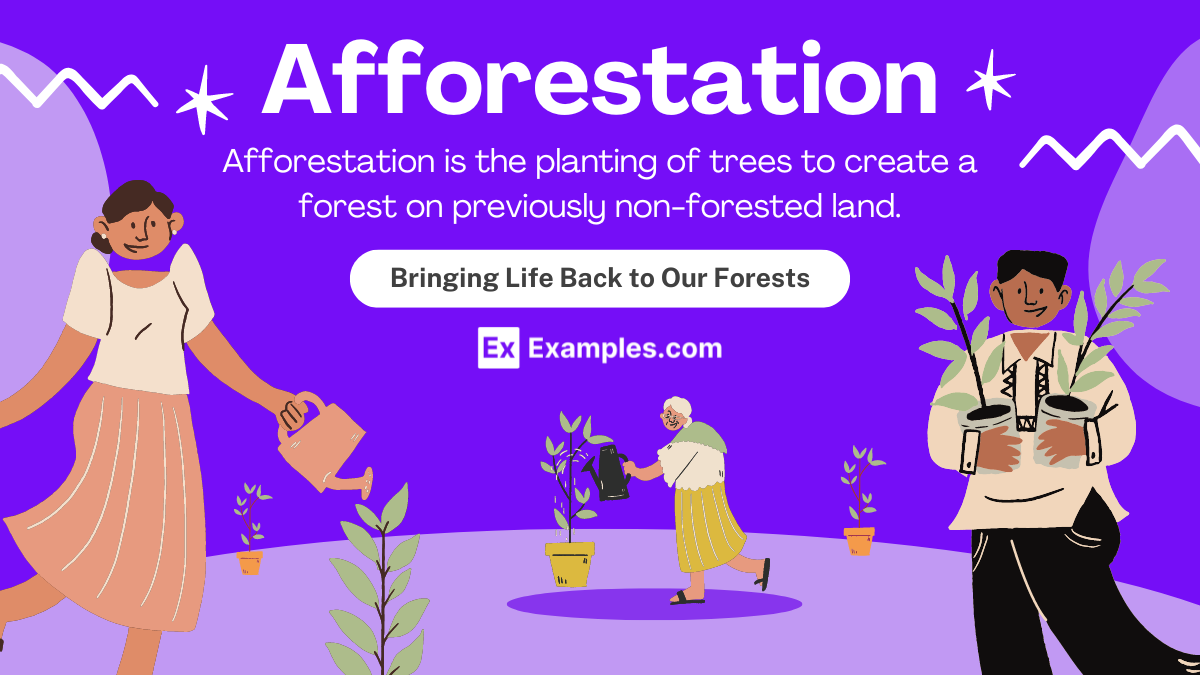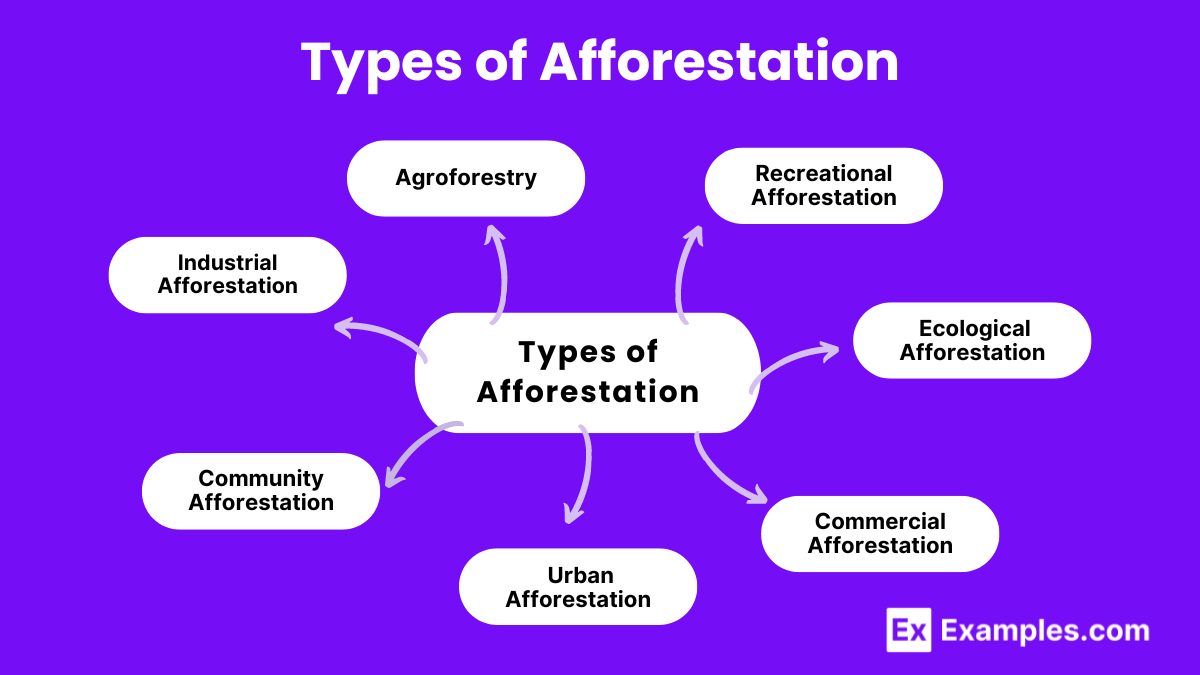What is afforestation?
Cutting down trees
Planting trees in a deforested area
Planting trees in a previously non-forested area
Replanting trees in a forested area


Afforestation refers to the process of planting trees in areas that have not been forested for a long time or have never been forested. This practice plays a crucial role in combating climate change, restoring ecosystems, and promoting biodiversity. By increasing tree cover, afforestation helps sequester carbon dioxide from the atmosphere, improving air quality and mitigating the effects of global warming. Additionally, it provides habitat for wildlife, enhances soil quality, and supports water conservation. Understanding the importance of afforestation and its implementation strategies can significantly contribute to sustainable environmental management and ecological balance.
Afforestation is the process of planting trees in an area where there were no previous tree cover or forests. This deliberate and planned activity aims to create new forests on lands that have not been recently forested, contributing to environmental conservation, carbon sequestration, and habitat restoration. Afforestation helps improve air quality, combat soil erosion, enhance biodiversity, and support water conservation efforts. By converting open lands into forested areas, afforestation plays a vital role in promoting ecological balance and mitigating the effects of climate change.
The Great Green Wall initiative aims to create an 8,000 km long barrier of trees across the width of Africa, from Senegal to Djibouti. This project combats desertification in the Sahel region and promotes sustainable land management.
Also known as the “Green Great Wall,” this project involves planting trees across northern China to stop the spread of the Gobi Desert. It’s one of the largest afforestation projects globally, aiming to plant 88 million acres of new forest.
India’s government has implemented several afforestation programs to increase forest cover and improve the ecological balance. The National Afforestation Program (NAP) focuses on rehabilitating degraded forests and expanding tree cover.
Launched in 2014, Pakistan’s Billion Tree Tsunami aimed to restore 350,000 hectares of forest in Khyber Pakhtunkhwa province. The project surpassed its target and has become a model for large-scale afforestation efforts.
This initiative aims to restore 15 million hectares of the Atlantic Forest by 2050. The project focuses on reforestation and sustainable land use, enhancing biodiversity and carbon sequestration.
Founded by Nobel laureate Wangari Maathai, the Green Belt Movement focuses on tree planting, environmental conservation, and women’s empowerment. Since its inception, the movement has planted over 51 million trees across Kenya.
Developed by Dr. Akira Miyawaki, this method involves planting native species in a dense, small-scale forest. This technique has been successfully implemented in various countries, including India, Malaysia, and France, to create fast-growing urban forests.
Ethiopia has undertaken several large-scale reforestation projects to combat deforestation and soil erosion. In 2019, Ethiopians planted over 350 million trees in a single day, setting a world record and highlighting the nation’s commitment to afforestation.
Launched in 2011, the Bonn Challenge is a global effort to restore 350 million hectares of deforested and degraded land by 2030. Countries worldwide have committed to this challenge, aiming to increase forest cover and promote sustainable land management.
Part of India’s National Action Plan on Climate Change, the Green India Mission aims to protect, restore, and enhance India’s diminishing forest cover. The project focuses on reforestation, improving forest-based livelihoods, and increasing biodiversity.
Identify Suitable Land:
Assess Soil Quality:
Species Selection:
Design Layout:
Clear the Land:
Soil Preparation:
Seedling Preparation:
Planting Technique:
Watering:
Weeding:
Mulching:
Fertilization:
Protection:
Growth Monitoring:
Management Practices:
Long-term Sustainability:
Afforestation is crucial for several reasons. Firstly, it helps combat climate change by absorbing carbon dioxide from the atmosphere, thereby reducing the greenhouse effect and global warming. Secondly, afforestation aids in restoring ecological balance by providing habitat for wildlife, promoting biodiversity, and stabilizing ecosystems. Additionally, forests play a vital role in the water cycle by enhancing groundwater recharge, preventing soil erosion, and reducing the risk of floods. Economically, afforestation supports livelihoods through sustainable forestry practices, providing resources such as timber and non-timber forest products. Furthermore, it improves air quality and offers recreational spaces for human well-being. Overall, afforestation is essential for environmental sustainability and human survival.

Afforestation encompasses several methods, each suited to different environmental and social contexts. Understanding the various types helps in selecting the most appropriate strategy for specific goals and conditions.
The Great Green Wall is an ambitious project aiming to create a 8,000-kilometer belt of trees across the width of Africa. This initiative, launched in 2007, spans 21 countries and aims to combat desertification, improve food security, and provide jobs.
Key Highlights:
Developed by Japanese botanist Akira Miyawaki, this method involves planting dense, native forests that grow rapidly and require minimal maintenance. This technique has been adopted worldwide for urban afforestation.
Key Highlights:
China’s Green Great Wall is one of the largest afforestation projects globally, aiming to create a series of forest belts to combat desertification and sandstorms.
Key Highlights:
India’s National Afforestation Program aims to restore degraded forests and increase the country’s forest cover.
Key Highlights:
The Bonn Challenge is a global effort to bring 350 million hectares of deforested and degraded land into restoration by 2030.
Key Highlights:
Afforestation is the process of planting trees in barren or deforested areas to create new forests.
Afforestation combats climate change, reduces soil erosion, improves biodiversity, and provides habitats for wildlife.
Afforestation absorbs CO2, produces oxygen, stabilizes soil, and supports ecosystems.
Native species are best for afforestation as they adapt well to the local environment and support biodiversity.
Afforestation creates new forests in non-forested areas, while reforestation restores forests in previously forested areas.
Afforestation sequesters carbon dioxide, mitigating the greenhouse effect and reducing global warming.
Challenges include selecting appropriate species, ensuring soil fertility, water availability, and protecting young trees from pests.
Yes, afforestation can stabilize soil, reduce wind erosion, and increase moisture retention, helping prevent desertification.
Governments create policies, fund projects, and engage communities in afforestation initiatives.
Individuals can plant trees, support afforestation projects, volunteer in local initiatives, and raise awareness about the benefits of afforestation.
Text prompt
Add Tone
10 Examples of Public speaking
20 Examples of Gas lighting
What is afforestation?
Cutting down trees
Planting trees in a deforested area
Planting trees in a previously non-forested area
Replanting trees in a forested area
Which of the following is a primary goal of afforestation?
Increasing urban development
Enhancing soil erosion
Increasing forest cover
Decreasing biodiversity
What is a significant environmental benefit of afforestation?
Increased carbon sequestration
Decreased oxygen production
Increased soil erosion
Decreased biodiversity
Which of the following activities is the opposite of afforestation?
Deforestation
Reforestation
Urbanization
Agriculture
Afforestation can help prevent:
Soil erosion
Air pollution
Water pollution
All of the above
Which of the following is a challenge associated with afforestation?
Increased biodiversity
Loss of natural habitats
High initial costs
Improved soil fertility
In which region would afforestation be most beneficial?
Urban areas
Deserts
Grasslands
Coastal areas
Which tree species would be ideal for afforestation in a dry region?
Pine
Oak
Eucalyptus
Mangrove
Afforestation contributes to the water cycle by:
Reducing transpiration
Increasing evaporation
Enhancing infiltration and groundwater recharge
Decreasing precipitation
Which of the following is a social benefit of afforestation?
Decreased employment opportunities
Reduced recreational spaces
Improved air quality
Decreased tourism
Before you leave, take our quick quiz to enhance your learning!

